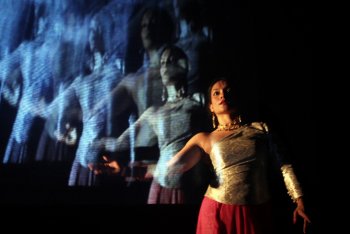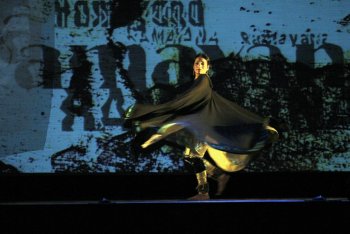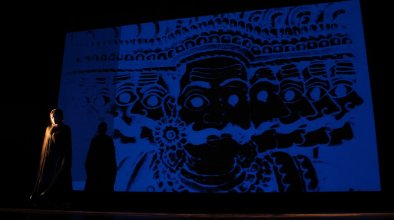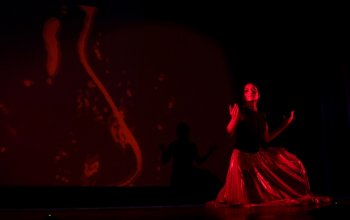
|   |

|   |
Ashavari Majumdar's Surpanakha - an experiment in Kathak - Dr. Sunil Kothari e-mail: sunilkothari1933@gmail.com Photos: Roshni Ali May 7, 2012 When I received a call from Kolkata from Kathak dancer Ashavari Majumdar requesting me to save the date 20th April 2012 for an evening at Habitat Centre, I could not place her. She sent me an e-invite in advance and it simply stated 'Surpanakha- an experiment in Kathak.' She followed it up with a few phone calls, knowing that dance calendar in Delhi gets full with simultaneous performances and critics may not turn up, and audiences also get divided. I am glad I attended her performance. It was an interesting experiment. With projection of visuals, four live musicians - vocalist, sarangi player, a tabla player and a pakhavaj player - a team of light designer and projectionists for visuals. A screen on the stage was placed before a white backdrop. With the strains of melodious sarangi and playing of tabla, the mood was set. Ashavari entered dressed in a cut size silver blouse, revealing right shoulder and attired in a flared ghaghara (skirt) in off white colour, taking pirouettes like a whirlwind, covering the stage and after a while, stood near the mike. Collecting her breath, she introduced the topic. Taking full advantage of talking to the audience as Kathak dance form allows, she started telling the story of Surpanakha, who had her nose cut off by Lakshmana when she made advances to him after Rama sent her to him. With nose covered, taking a symbolic posture, Ashavari with projection on the screen creating environmental ambience, forest, stone walls, let loose a storm. The mood of Surpanakha was enhanced further by the flaring whirling ghaghara. With a commanding stage presence, she looked like a royal princess, sister of King Ravana. 

She told of about 300 Ramayanas. Familiar ones of Valmiki, Kamban, Adbhuta Ramayana, Jain Ramayana, Cambodian, Indonesia, from Malaysia and so on. Using all the elements of Kathak, foot work, small pieces of nritta, aamad like 'dha taka thunga', postures of thaat, chakkars et al, she revealed her approach to experimentation with a lucid commentary, Surpanakha's asking Ravana to take revenge, to abduct Sita and combat with Rama. In terms of visuals to supplement the narrative and incidents from other Ramayanas, developing Surpanakha's character, she employed excellent vocal music composition like 'Piya ghar nahi mora', which elevated the production, as without exaggerated, rather minimal abhinaya, relying more on angikabhinaya, bodily movements, she succeeded in conveying the agony of Surpanakha's state of mind, looking for love. At times, repeating Surpanakha separating each syllable like mnemonic syllables, bols, also looked interesting. Interesting were versions where she told of Jain Ramayana where Sita is daughter of Ravana and Mandodari. Therefore, Sita and Surpanakha are sisters. One delicate, the other robust. Alternating the roles of Sita and Surpanakha, Ashavari imaginatively used percussions gentle and loud, with projection of two faces and humming of sister, sister. In another sequence with projection of a mask of ten headed Ravana she spoke brother brother, brother effectively, with lights changing. In the sequence of her passion and agony, love and lust for Rama, the saffron light heightened the impact. The sync was superb with visuals, lighting, music and Ashavari's movements. In the second sequence when she came with black costume covering her head and the way she moved, those images looked powerful. The use of mask (was it from Sri Lanka?) for depicting the 'grotesque' beauty of Surpanakha was effective. She spoke holding the mask in front of her face, describing the beauty of a woman's face. The ploy was interesting, giving an extra dimension, the ever changing lights and visuals, her moving round the screen, with back to audience and close to the backdrop, trying to reach out high, with flagging arms, retaining the Kathak technique. There were sharp arm movements taking them towards the floor, two arms with razor sharp cross movements across the face, sometimes the 'ada' and 'andaz' of Kathak enhancing grace of a feminine character - all were intelligent elements she let loose. The use of tatkar, foot work, to display Surpanakha's anger, anguish had the desired effect. What Birju Maharaj invests while performing mentioning how tala, the time cycle can be Gopis in search of Krishna, sam was used by Ashavari, explaining the running of the nayika, Surpanakha, with tatkar, foot work, and the mnemonics of tabla, the foot falls of Rama, going ahead. Even deconstructing aamad 'dha taka dhunga,' the emotive quality was employed effectively. These are known explorations and its use looked quite interesting as the clapping, musicians accompanying the clapping, the sound created by rustling thumb and index finger, yes, reminding one of similar use by Aditi Mangaldas and Daksha Sheth, still looked worth exploring as it added to the overall impact. 

At times the focus seemed to shift to Sita. Ashavari through nritta with use of light enacted Sita's ordeal by fire to prove her purity. Sarcasm, agony, anguish, pain all converged in saying aloud, 'I am impure.' The soliloquies brought dramatic impact. At times, through tatkar, reciting questions, Ashavari asked spectators to judge Surpanakha. Once, the vocalist resorted to singing in English and it was so tuneful that one did not mind use of English lyric - though it was incongruent - but the music was overpowering. And one ignored it. No need to sing English lyric. Narration in English does not look odd as the singing. In the finale, the rendering of the thumri 'Rasa ke bhara tore naina sanwaria' was hauntingly melodious and Ashavari expressed abhinaya using traditional vocabulary of a nayika preparing herself looking into the mirror, preparing bed of flowers to receive the lover and so on. The music overpowered the dance and also the Ramastuti when concluding, looked over drawn. It would leave great impact if Ramastuti could be edited. The performance to live music added an extra dimension as the team of musicians was just brilliant. If Ashavari's conceptualization and performance were received with enthusiasm, it was obvious that with the support of India Foundation for Arts, Bangalore, Ashavari has worked very hard with a team of visual artists, lights designer and musicians for her experiment in Kathak. Such teamwork left an indelible impression. Ashavari has studied for long under Vijay Shankar, a renowned disciple of Pandit Birju Maharaj and later on under Birju Maharaj. She has very good command over technique which is further embellished by her stage presence. She said that she used to see me at Shyamanand and Chetna Jalan's Padatik in Kolkata during my tenure as a Professor at Rabindra Bharati University in the eighties. She must have been a very young girl then. But seems within two decades, Ashavari has matured as a dancer and taken confident steps in exploring Kathak boldly. A programme book with choreographer's note, synopsis (and of course credits to the musicians, lights designers, visual artists) would help audience to follow the sequences and references to Ramayanas. The credits were screened but they ran too fast to register the names. Even when Ashavari managed to speak through mike without much difficulty of breathing, at times her commentary was inaudible. She would do well to overcome such minor lapses with careful presentation. She deserves to be seen more often in the Capital and in other cities, as there is a breath of fresh air in approach to Surpanakha's character.  Dr. Sunil Kothari is a dance historian, scholar, author and a renowned dance critic. He is Vice President of World Dance Alliance Asia Pacific India chapter, based in New Delhi. He is honored by the President of India with Padma Shri, Sangeet Natak Akademi award and Senior Critic Award from Dance Critics Association, NYC. He is a regular contributor to www.narthaki.com, the roving critic for monthly magazine Sruti and is a contributing editor of Nartanam for the past 11 years. Post your comments Pl provide your name and email id along with your comment. All appropriate comments posted with name and email id in the blog will also be featured in the site. |